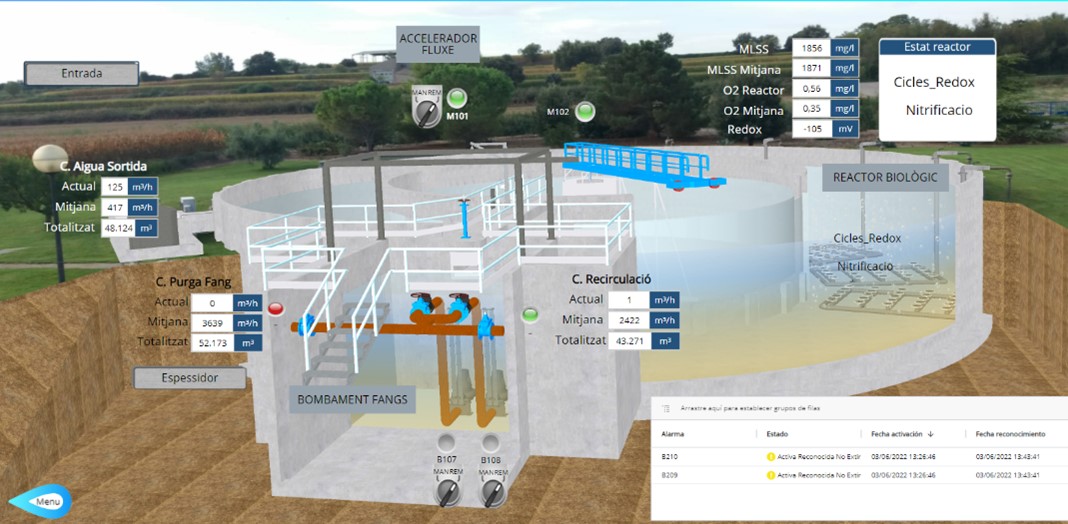The main objective of wastewater treatment plant (WWTP) management is to achieve the required standards of treated water quality at the lowest possible operating cost and with the minimum environmental impact by the lack of digital transformation. This challenge is particularly important in a context in which WWTP operators must be able to process and transform the immense amount of data from multiple and heterogeneous sources into real actions.
Against this background, the implementation of Information Management Systems (IMS) in WWTPs is the best way to capture, standardize and unify this data. Therefore, a single source of interlinked data is established to harness all the potential of the information actually available. This is outlined by the multinational Idrica in a recent report entitled “Digital transformation of WWTPs: the key to a more sustainable future”.
These IMS become even more important in a context in which WWTPs are relentlessly pursuing digital transformation through the introduction of new technologies that give operators a more accurate understanding of their treatment processes through LIMS, CMMS and SCADA, complemented by state-of-the-art sensors. In particular, real-time data acquisition provided by the increasing deployment of sophisticated instrumentation is transforming the way infrastructures operate, enabling faster, better-informed decision-making.
Integrating sources into a single environment
New platforms must enable the next step in the digital transformation journey, which is to integrate all these data sources into a single environment. This is crucial. According to Jacobo Illueca, a Wastewater Specialist at Idrica, “This enables the WWTP operator to comprehensively control all its processes through dashboarding, alert systems, data quality controls and real-time calculation of operational KPIs to monitor compliance with operational quality and financial objectives”. In addition, the expert pointed out that it is essential to have a single repository where all the data from the wastewater treatment plant is available, regardless of its type and source, “so as to move forward swiftly and deliver robust results”.
At a more advanced stage of digital transformation, this data is used to create, train and feed predictive models, simulations, anomaly detection algorithms and decision support systems. These all aim to improve plant operation in terms of quality, cost, environmental impact and transparency.

Stages prior to digital transformation
To ensure the optimal digital transformation of WWTPs, Idrica recommends taking two initial steps in its report: preliminary consultancy work at the WWTP and the implementation of data management systems.
In the first consultancy step, a digital diagnosis of the WWTP is carried out by analyzing its starting point and establishing specific objectives adapted to the reality of the plant in agreement with the operator. The result is a customized action plan to meet these objectives.
Secondly, the implementation of data management systems enables the integration of all WWTP data, standardizing it with advanced intelligence and presenting the most relevant system information to the user through a single holistic dashboard. Thanks to this system, “WWTP managers can monitor all plant operations from a single
interface. In addition, this type of system can be used to create rules of all types to automate the treatment plant’s processes, creating alarms for each one,” stated the Idrica Wastewater Specialist, Jacobo Illueca.
Eight Characteristics of the Best WWTP Technology
Not all technology is suitable for the digital transformation of WWTPs. It must comply with a series of characteristics to enable operators to develop the main use cases mentioned below. According to the report drawn up by Idrica, the technology must be:
- Adaptable, enabling integration with multiple user authentication systems (auth/login) and taking different data repositories into account.
- Flexible, enabling standard customizations and specific behaviours according to the established business processes.
- Scalable, capable of responding as the number of users increases.
- Multi-environment, enabling on-premise, private cloud and cloud-based (service-based) deployments.
- Competitive, capable of operating with third-party technologies and affordable licenses, with a low initial hardware footprint and high availability if required.
- Easy to deploy, with automated pipelines, and available both on-premise and in the cloud, with reliable roll-back processes.
- Easy to maintain, with efficient logging, enabling remote and centralized monitoring.
- Easy to implement, having rich and well-documented APIs without direct access to the database and business logic to prevent damage to the system.
The digital transformation of WWTPs is, therefore, a key process that must be carried out to minimize costs while increasing both productivity and efficiency. This is especially relevant at a time like the present, with population growth and climate change playing a key role in the field of water management.
Read more articles from Idrica:
Idrica to digitally transform water billing in Northern Peru
Idrica, a key partner in the digital transformation of the Smart City of Valencia







